The answer to the picture cube question is C.
Warm-ups
September 7:

September 6:

September 3:

September 2:

August 31:

August 30:

Maths Challenges
September 7, Ball Problem
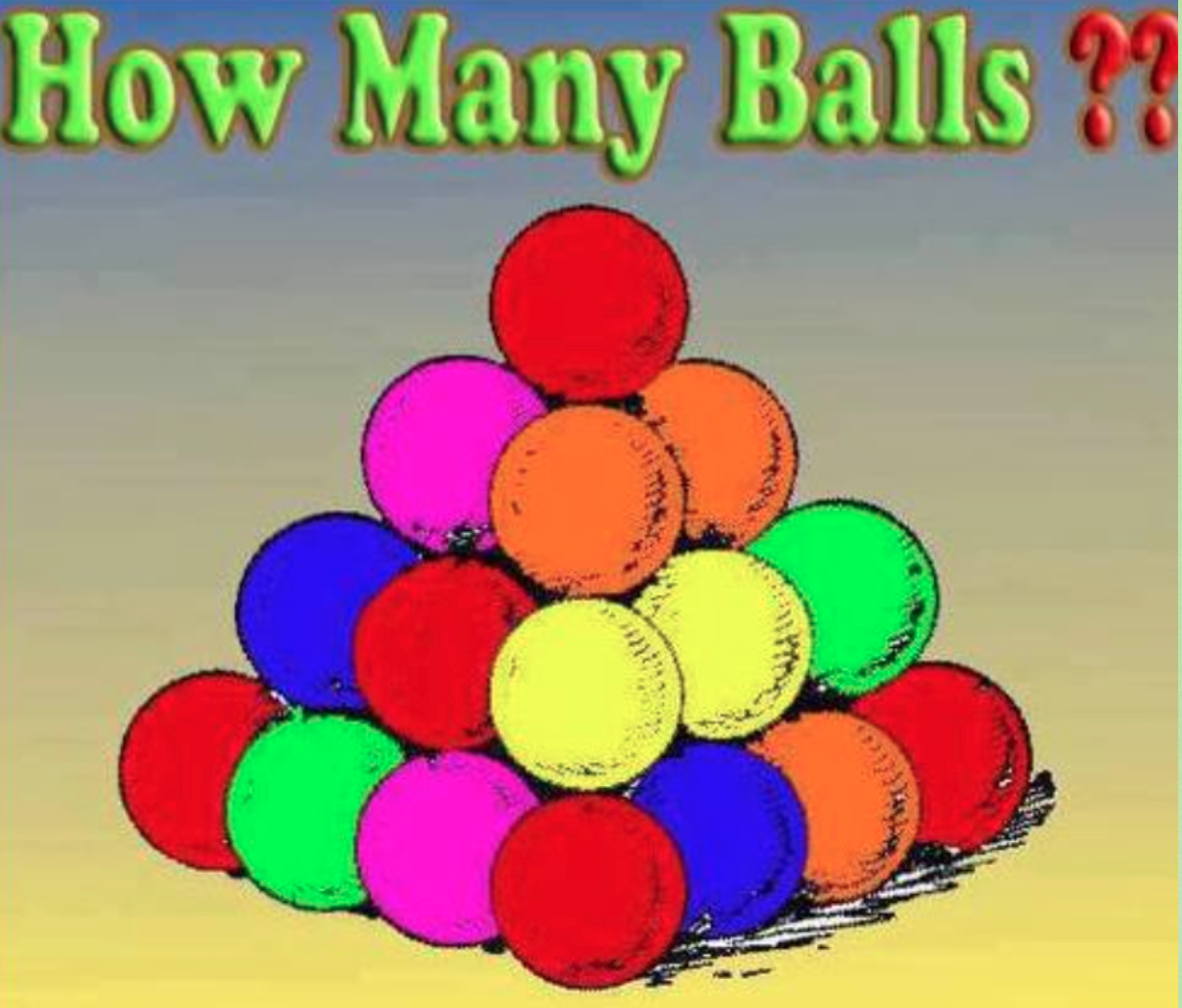
The bottom layer has 4 rows of 4 so 4 x 4 = 16.
The second layer has 3 rows of 3 so 3 x 3 = 9.
The third layer has 2 rows of 2 so 2 x 2 = 4.
There is 1 ball on top.
So 16 + 9 + 4 + 1 = 30. There are 30 balls.
September 6 Flower Problem

This can be solved with the equation 60 ÷3 = 20

We know the red flower is 20, so we can subtract that.

This can be solved with the equation 10 ÷2 = 5
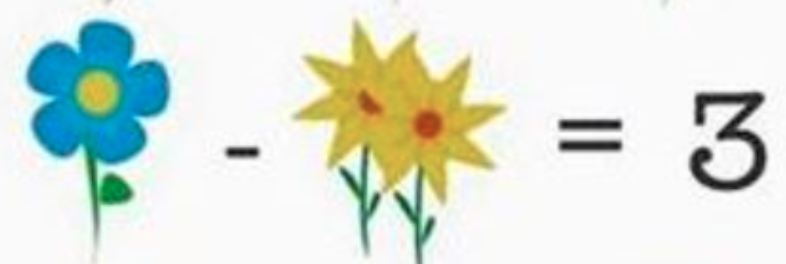 We know the blue flower is 5, so this means 5 – 2 = 3. The flowers are 2. So each yellow flower is 1.
We know the blue flower is 5, so this means 5 – 2 = 3. The flowers are 2. So each yellow flower is 1.

Now we know the values of all of the flowers: 1 + 20 + 5 = 26
September 3, Triangles Problem
There are 24 triangles:
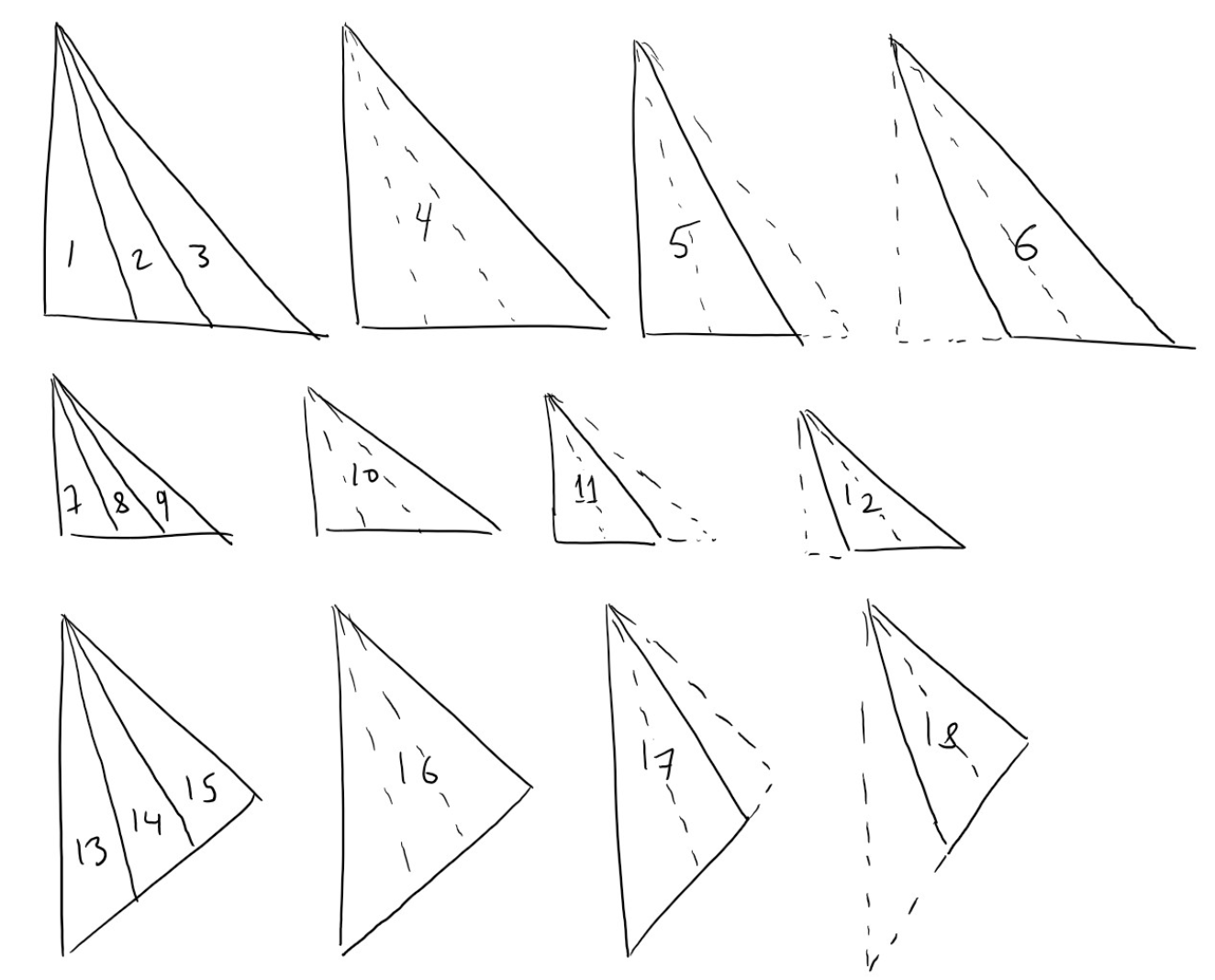

September 2, Blocks Problem
There are four arms in the block pattern. Each arm has 15 blocks and there are another 6 blocks in the centre. So the answer is (4 x 15) + 6 = 66 blocks.

August 31, Pizza Problem
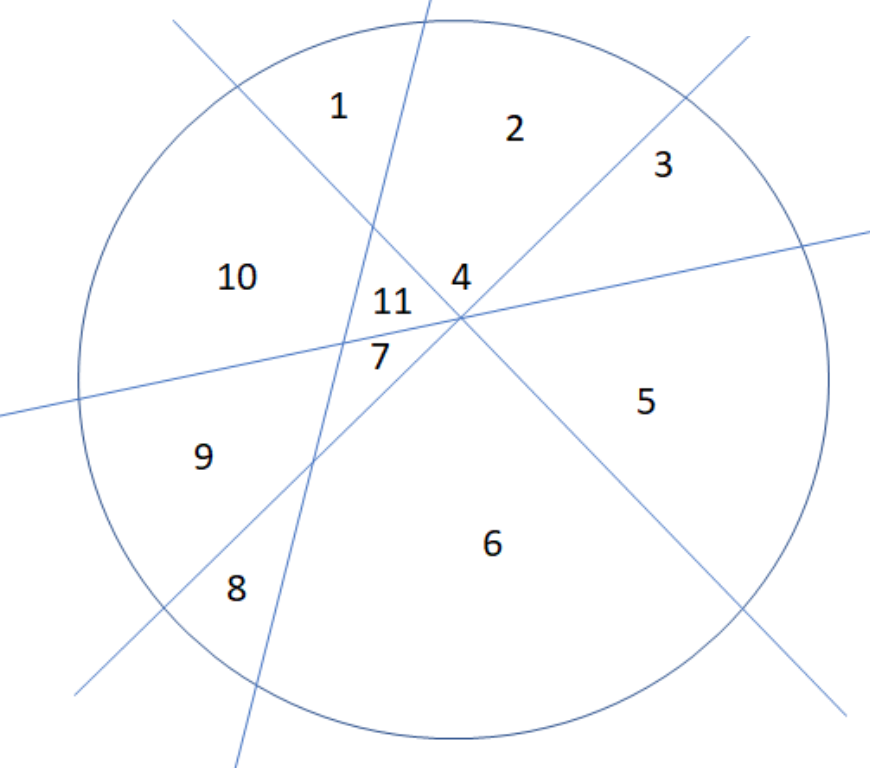
August 30, Roald Dahl Challenge 2:
The value of the characters is as follows:
The Twits (older couple) are 5,
George (boy) is 25,
Willy Wonka (man with the cane) is 50,
Enormous Crocodile is 10
and Matilda (girl) is 30.
August 27, Falling Origami Papers Problem Maths Challenge:

August 26, Roald Dahl Math Challenge 1:
Order of George’s bottles is as follows: Blue, Purple, Red, Green, Orange and Yellow.
Imposters
August 27:

The first imposter is blue (48 ÷ 8 = 6). Maybe you know this as a basic fact.
The second imposter is orange (48 x 2 = 96). One strategy for this is to remember that 50 x 2 = 100. 50 – 48 = 2. We then subtract 2 x 2 from 100: 100 – 4 = 96.
The third imposter is dark grey (88 x 2 = 176). One strategy for this is to double 80 which is 160. Then double 8 which is 16. So 160 + 16 = 176.
The fourth imposter is brown (28 x 3 = 84). You can work this out by multiplying 20 by 3 which is 60. Then 8 x 3 = 24. 60 + 24 = 84.
August 26:

The first imposter is blue (66 ÷ 3 = 21). I worked this out 30 ÷ 3 = 10, so 60 ÷ 3 = 20. Then there are two more groups of 2 which means 20 + 2 = 21.
The second imposter is green (125 x ⅕ = 125, not 125 x ⅙).
Here is some more instructions on how to multiple a whole number by a fraction:
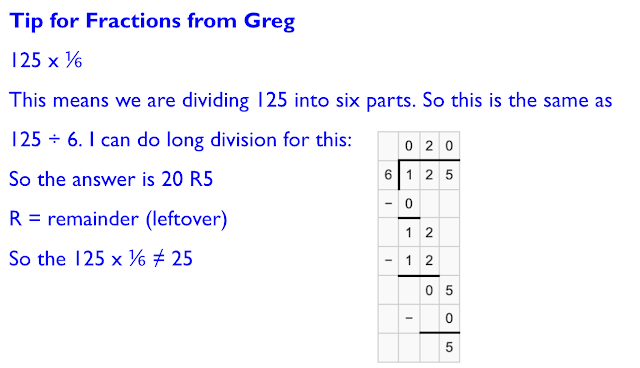
August 25:

The first imposter is orange (126 ÷ 6 = 21). I worked this out 60 ÷ 6 = 10, so 120 ÷ 6 = 20.
Then there is one more group of 6 which means 20 + 1 = 21.
The second imposter is brown (1234 + 5678 = 6912). I used column addition to calculate this:
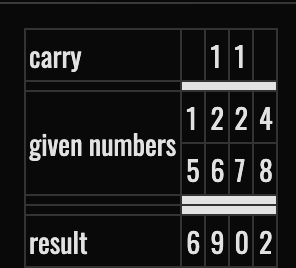
Every other equation was correct so there were only two imposters.
Numbers of the Day
Thursday, August 26
12
twelve;
even;
half it = 6;
double it = 24;
tens = 1, ones = 2;
10 less = 2, 10 more = 22, 100 less = -88, 100 more = 112;
add 15 = 27, subtract 7 = 5, multiply by 6 = 72, divide by 3 = 4;
12 x 10 = 120, 12 x 100 = 1200, 12 ÷ 10 = 1.2, 12 ÷ 100 = 0.12
Your number line example with 12 highlighted:

Number sentence (equation) example:
12 + 5 = 17
86
eighty-six;
even;
half it = 43;
double it = 172;
tens = 8, ones = 6;
10 less = 86, 10 more = 96, 100 less = -14, 100 more = 186;
add 15 = 101, subtract 7 = 79, multiply by 6 = 516, divide by 3 = 28 R2;
86 x 10 = 860, 86 x 100 = 8600, 86 ÷ 10 = 8.6, 86 ÷ 100 = 0.86
Your number line example with 86 highlighted:

Number sentence (equation) example:
81 + 5 = 86
972
nine-hundred and seventy-two;
even;
half it = 486;
double it = 1944;
hundreds = 9, tens = 7, ones = 2;
10 less = 962, 10 more = 982, 100 less = 872, 100 more = 1072;
add 15 = 987, subtract 7 = 965, multiply by 6 = 5,832 (I used the columns strategy), divide by 3 = 324 (I used long division);
972 x 10 = 9,720; 972 x 100 = 97,200; 972 ÷ 10 = 97.2, 972 ÷ 100 = 9.72
Your number line example with 972 highlighted:

Number sentence (equation) example:
972 + 5 = 977
5,762
five-thousand, seven-hundred and sixty-two;
even;
half it = 4,881;
double it = 11,524;
thousands = 5, hundreds = 7, tens = 6, ones = 2;
10 less = 5,752, 10 more = 5,772, 100 less = 5,662, 100 more = 5,862;
add 15 = 5,777; subtract 7 = 5,655; multiply by 6 = 34,572 (I used the columns strategy), divide by 3 = 1,920 R2 (I used long division);
5,762 x 10 = 57,620; 5,762 x 100 = 576,200; 5,762 ÷ 10 = 576.2; 5,762 ÷ 100 = 57.62
Your number line example with 5,762 highlighted:

Number sentence (equation) example:
5,762 + 5 = 5,767
Wednesday, August 25
10 (It doesn't hurt to do it again!)
ten;
even;
half it = 5;
double it = 20;
tens = 1, ones = 0;
10 less = 0, 10 more = 20, 100 less = -90, 100 more = 110;
add 15 = 25, subtract 7 = 3, multiply by 6 = 60, divide by 3 = 3 R1;
10 x 10 = 100, 10 x 100 = 1,000, 10 ÷ 10 = 1, 10 ÷ 100 = 0.1
Your number line example with 10 highlighted:

Number sentence (equation) example:
10 + 5 = 15
20
twenty;
even;
half it = 10;
double it = 40;
tens = 2, ones = 0;
10 less = 10, 10 more = 30, 100 less = -80, 100 more = 120;
add 15 = 35, subtract 7 = 13, multiply by 6 = 120, divide by 6 = 3 R2;
20 x 10 = 200, 20 x 100 = 2,000, 20 ÷ 10 = 2, 20 ÷ 100 = 0.2
Your number line example with 20 highlighted:

Number sentence (equation) example:
20 + 5 = 25
67
sixty-seven;
odd;
half it = 33.5;
double it = 134;
tens = 6, ones = 7;
10 less = 57, 10 more = 77, 100 less = -33, 100 more = 167;
add 15 = 82, subtract 7 = 60, multiply by 6 = 402, divide by 3 = 22 R1;
67 x 10 = 670, 67 x 100 = 6,700, 67 ÷ 10 = 6.7, 81 ÷ 100 = 0.67
Your number line example with 8 highlighted:

Number sentence (equation) example:
67 + 5 = 72
928
nine-hundred and twenty-eight;
even;
half it = 464;
double it = 1,856;
hundreds = 9, tens = 2, ones = 8;
10 less = 918, 10 more = 938, 100 less = 828, 100 more = 1,028;
add 15 = 942, subtract 7 = 921, multiply by 6 = 5,568 (I used the columns strategy), divide by 3 = 309 R1 (I used long division);
928 x 10 = 9,280; 928 x 100 = 92,800; 928 ÷ 10 = 92.8, 928 ÷ 100 = 9.28
Your number line example with 928 highlighted:

Number sentence (equation) example:
928 + 5 = 933
4,632
four-thousand, six-hundred and thirty-two;
even;
half it = 2,616;
double it = 9,264;
thousands = 4, hundreds = 6, tens = 3, ones = 2;
10 less = 4,622, 10 more = 4,642, 100 less = 4,532, 100 more = 4,732;
add 15 = 4,647; subtract 7 = 4,625; multiply by 6 = 27,792 (I used the columns strategy), divide by 3 = 1,544 (I used long division);
4,632 x 10 = 46,320; 4,632 x 100 = 463,200; 4,632 ÷ 10 = 463.2; 4,632 ÷ 100 = 46.32
Your number line example with 4,632 highlighted:

Number sentence (equation) example:
4,632 + 5 = 4,637
Tuesday, August 24
5
five;
odd;
half it = 2.5;
double it = 10;
tens = 0, ones = 5;
10 less = -5, 10 more = 15, 100 less = -95, 100 more = 105;
add 15 = 20, subtract 7 = -2, multiply by 6 = 30, divide by 3 = 1 R2;
5 x 10 = 50, 5 x 100 = 500, 5 ÷ 10 = 0.5, 5 ÷ 100 = 0.05
Your number line example with 5 highlighted:

Number sentence (equation) example:
5+ 5 = 10
81
eighty-one;
odd;
half it = 40.5;
double it = 162;
tens = 8, ones = 1;
10 less = 71, 10 more = 91, 100 less = -19, 100 more = 181;
add 15 = 96, subtract 7 = 74, multiply by 6 = 486, divide by 3 = 27;
81 x 10 = 810, 81 x 100 = 8100, 81 ÷ 10 = 8.1, 81 ÷ 100 = 0.81
Your number line example with 8 highlighted:

Number sentence (equation) example:
81 + 5 = 86
639
six-hundred and thirty-nine;
odd;
half it = 319.5;
double it = 1,278;
hundreds = 6, tens = 3, ones = 9;
10 less = 629, 10 more = 649, 100 less = 539, 100 more = 739;
add 15 = 654, subtract 7 = 632, multiply by 6 = 3,834 (I used the columns strategy), divide by 3 = 213 (I used long division);
639 x 10 = 6,390; 639 x 100 = 63,900; 639 ÷ 10 = 63.9, 639 ÷ 100 = 6.39
Your number line example with 639 highlighted:

Number sentence (equation) example:
639 + 5 = 644
3,490
three-thousand, four-hundred and ninety;
even;
half it = 1,745;
double it = 6,980;
thousands = 6, hundreds = 4, tens = 9, ones = 0;
10 less = 3,480, 10 more = 3,500, 100 less = 3,390, 100 more = 3,590;
add 15 = 3,505; subtract 7 = 3,483; multiply by 6 = 20,940 (I used the columns strategy), divide by 3 = 1,163 R1 (I used long division);
3,490 x 10 = 34,900; 3,490 x 100 = 349,000; 3,490 ÷ 10 = 349; 3,490 ÷ 100 = 34.9
Your number line example with 3,490 highlighted:

Number sentence (equation) example:
3,490 + 5 = 3,495
76,200
seventy-six-thousand, two-hundred;
even;
half it = 38,100;
double it = 152,400;
thousands = 76, hundreds = 2, tens = 0, ones = 0;
10 less = 76,190, 10 more = 76,210, 100 less = 76,100, 100 more = 76,300;
add 15 = 76,215; subtract 7 = 76,193; multiply by 6 = 457,200 (I used the columns strategy), divide by 3 = 25,400 (I used long division);
76,200 x 10 = 762,000; 76,200 x 100 = 7,620,000; 76,200 ÷ 10 = 7,620; 76,200 ÷ 100 = 762
Your number line example with 76,200 highlighted:

Number sentence (equation) example:
76,200 + 5 = 76,205
Monday, August 23
10
ten;
even;
half it = 5;
double it = 20;
tens = 1, ones = 0;
10 less = 0, 10 more = 20, 100 less = -90, 100 more = 110;
add 15 = 25, subtract 7 = 3, multiply by 6 = 60, divide by 3 = 3 R1;
10 x 10 = 100, 10 x 100 = 1,000, 10 ÷ 10 = 10, 10 ÷ 100 = 0.1
Your number line example with 10 highlighted:

Number sentence (equation) example:
10 + 5 = 15
67
sixty-seven;
odd;
half it = 33.5;
double it = 134;
tens = 6, ones = 7;
10 less = 57, 10 more = 77, 100 less = -33, 100 more = 167;
add 15 = 82, subtract 7 = 60, multiply by 6 = 402, divide by 3 = 22 R1;
67 x 10 = 670, 67 x 100 = 6700, 67 ÷ 10 = 6.7, 67 ÷ 100 = 0.67
Your number line example with 8 highlighted:

Number sentence (equation) example:
67 + 5 = 72
928
nine-hundred and twenty-eight;
even;
half it = 464;
double it = 1,856;
hundreds = 9, tens = 2, ones = 8;
10 less = 918, 10 more = 938, 100 less = 828, 100 more = 1,028;
add 15 = 943, subtract 7 = 921, multiply by 6 = 5,568 (I used the columns strategy), divide by 3 = 309 R1 (I used long division);
928 x 10 = 9,280, 928 x 100 = 92,800, 928 ÷ 10 = 92.8, 928 ÷ 100 = 9.28
Your number line example with 928 highlighted:

Number sentence (equation) example:
928 + 5 = 933
4,632
four-thousand, six-hundred and thirty-two;
even;
half it = 2,316;
double it = 9,264;
thousands = 4, hundreds = 6, tens = 3, ones = 2;
10 less = 4,622, 10 more = 4,642, 100 less = 4,532, 100 more = 4,732;
add 15 = 4,647, subtract 7 = 4,625, multiply by 6 = 27,792 (I used the columns strategy), divide by 3 = 1,544 (I used long division);
4,632 x 10 = 46,320, 4,632 x 100 = 463,200, 4,632 ÷ 10 = 463.2, 4,632 ÷ 100 = 46.32
Your number line example with 4,632 highlighted:

Number sentence (equation) example:
4,632 + 5 = 4,637





























